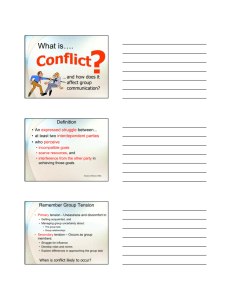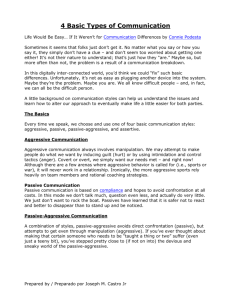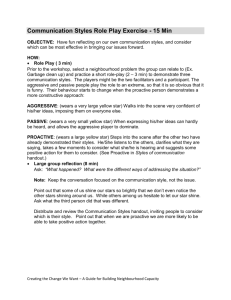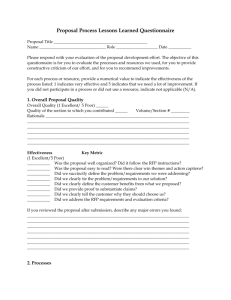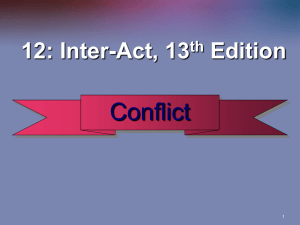to see a sample activity
advertisement
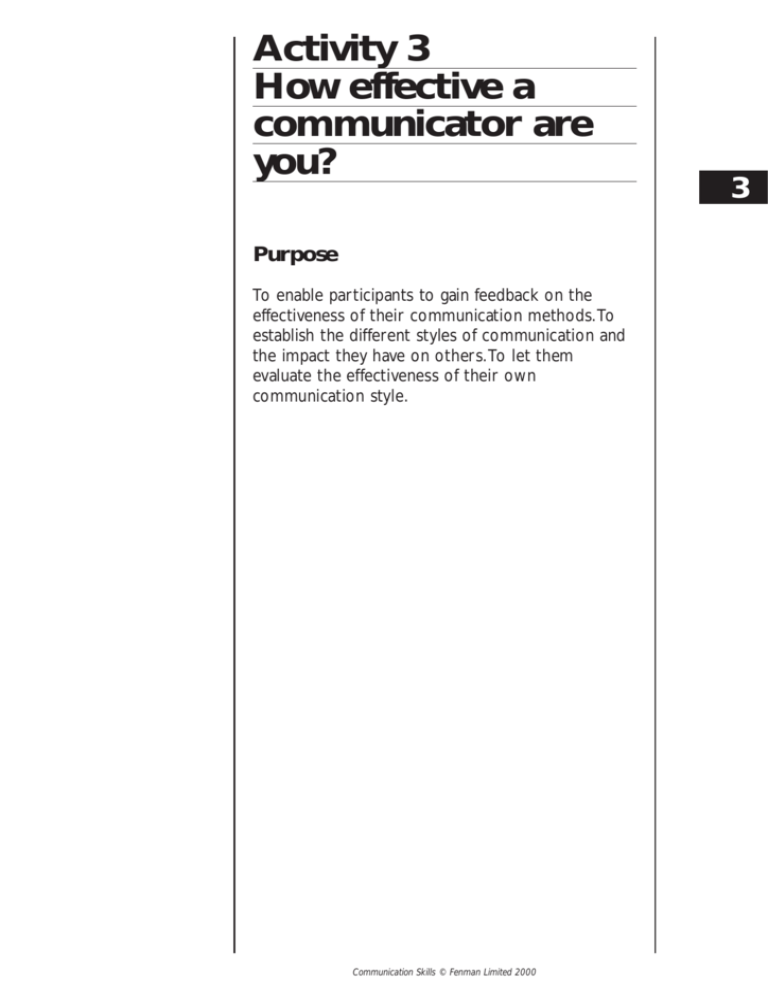
Activity 3 How effective a communicator are you? Purpose To enable participants to gain feedback on the effectiveness of their communication methods.To establish the different styles of communication and the impact they have on others.To let them evaluate the effectiveness of their own communication style. Communication Skills © Fenman Limited 2000 3 Activity 3 How effective a communicator are you? Introduction If people are to communicate effectively, they must choose the right method and do so in a manner which builds positive relationships.This is an activity which helps participants to understand the impact of their communication methods and their communication styles. Being aware of one’s own strengths and weaknesses in communicating is an important step in improving personal effectiveness. Purpose To enable participants to gain feedback on the effectiveness of their communication methods.To establish the different styles of communication and the impact they have on others.To let them evaluate the effectiveness of their own communication style. Application This activity can be used as a stand-alone training session or as part of a workshop on topics such as communication and assertiveness skills, conflict management, facilitation and training and development skills, leadership and team-building skills. What happens 3 You introduce the session and participants look at the types of communication channels they currently use. Participants discuss the findings of a communications survey that provides them with feedback on the effectiveness of their current communication methods.They then complete a selfassessment questionnaire on the way in which they communicate.You explain the different styles and participants discuss the implications of each. Participants then score their questionnaire, discuss the results and how they can increase the effectiveness of their communication style. 3–1 Communication Skills © Fenman Limited 2000 Time Overall time required: 1 hour 45 minutes ● ● ● ● ● ● Materials & resources ● 1 OHT master: 3.1 The iceberg ● 6 Handout masters: 3.2 Communication assessment 3.3 Individual assessment 3.4 Communication style questionnaire 3.5 Communication styles and their implications 3.6 Self-assessment: results 3.7 Increasing your communication effectiveness ● Overhead projector and screen Flipchart and stand or whiteboard Marker pens for trainer Flipchart paper and marker pens for participants Paper and pens for participants Space for small-group work ● ● ● ● ● Recommended group size In preparation Introduction: 10 minutes Effectiveness of communication methods: 35 minutes Communication styles: 20 minutes Communication styles – exercise: 20 minutes Improving communication effectiveness: 15 minutes Review: 5 minutes Four to twelve people. Prior to this session you will need to invite participants to nominate three people – colleagues, customers, team members or their manager – with whom they communicate on a regular basis. Issue Handout 3.2 Communication assessment, to these people and ask them to fill in the assessment about the participant attending the course.They can do this in confidence.You need to ensure that the assessments are returned to you prior to the training session taking place. 3–2 Communication Skills © Fenman Limited 2000 How do I do it? INTRODUCTION Introduce the session. Explain that the effectiveness of our communication in the workplace depends upon us choosing the most appropriate communication methods and communicating in the most effective way.This session will give participants an opportunity to uncover some of the blind spots in their communication, both in terms of the methods they use and their communication style. 3 Point out that new technologies have given people a wider range of communication channel options than ever before.The channel chosen to deliver a message can have a strong influence on its effectiveness. Tell participants to list the methods of communication they currently use.The list may include methods such as face-to-face communication, telephone, e-mail, audio- and videoconferencing, voice-mails, letters, memos, reports, bulletins, intranet, and Internet. Ask them to estimate the amount of time they spend communicating through each channel in percentage terms.Take feedback of examples and write up on a flipchart. Now ask them to estimate the division of time they spend between written and oral communication methods. Ask what, in general, oral communications are best for as opposed to written communication. Write responses on a flipchart. Point out that oral communication is best used when there is need for immediate feedback, for messages that require a personal dimension or for when there is a visual message to convey. Written communication (with the exception of e-mail) is best when you want to choose your words carefully or convey a more formal tone, when you want a formal record, or consideration needs to be given to the message.The choice of communication channel can also be affected by the culture of the organisation in which people work, Communication Skills © Fenman Limited 2000 3–3 for example some organisations are very e-mail driven. This introduction will take about 10 minutes. EFFECTIVENESS OF COMMUNICATION METHODS Remind participants that the best choice of communication method depends primarily on the nature of the message and the desired relationship between the sender and the receiver. Ask them to personally complete their assessment on the effectiveness of their communication methods up to and including question l: ‘What I think is a weakness about my communication methods is that . . .’. Allow 5 to 10 minutes.Then remind participants that, prior to coming to the session, they nominated three people to provide feedback on the effectiveness of their communication methods. Allocate 20 minutes for participants to look at the responses you have received, to compare these to their own self-assessment and to identify key areas for improvement.You may suggest that participants write the other people’s scores against each of the questions on their own individual assessment sheet so that they have a record and can make comparisons. In particular, encourage participants to complete question m ‘What other people would like me to do differently when communicating is . . .’ and question n ‘I will do this by . . .’. When people have completed their analysis and answered questions m and n, ask them to find a partner with whom to discuss and compare the actions they will take. Allow 5 minutes for discussion. 3–4 Communication Skills © Fenman Limited 2000 COMMUNICATION STYLES Point out that the style in which people communicate, as well as the channel they choose, can alter the effectiveness of the message that is received. Explain that the manner in which people do, say or write things gives a powerful message to others of what is below the waterline and cannot be seen: their attitudes, values and beliefs.The receivers of messages often make assumptions based on how they perceive the communication style of the sender. OHT 3.1 illustrates this point. 3 Explain that this is an opportunity for participants to identify their own communication style. Point out that there are no right or wrong answers in completing the questionnaire so people should answer this truthfully. Mention that they will have the option of sharing or not sharing their results. Allow 10 minutes for completion of the questionnaire. Explain that before looking at the results of the questionnaire, it is important to understand the different communication styles, why people use them and the impact they have on others. Draw the grid, shown on Handout 3.5 Communication styles and their implications, on a flipchart. If you have already used Activity 1 with the group, they will be familiar with the terminology. Explain that in communicating a message to someone, the recipient gains an impression of the other person based on how direct they are in expressing their views, wants and opinions – some people can be very direct and others less so, they imply or infer.They also gain an impression from the thought or consideration that the sender of the 3–5 Communication Skills © Fenman Limited 2000 message gives to the opinions, wants and needs of the recipient. Some people can be very thoughtful and others thoughtless. Explain that there are four communication styles: ● Aggressive: I am direct in expressing my needs, wants and opinions and I give no thought to other people’s. Approach: I win, you lose. ● Passive: I do not express my needs, wants and opinions directly. I put other’s needs above my own. Approach: I lose, you win. ● Passive aggressive: I indirectly make sure that others are aware of my needs, wants and opinions and that these are more important than theirs. Approach: I win, you lose. ● Assertive: I clearly express my needs, wants and opinions in a way which is considerate of others. Approach: I win, you win. These points are summarised in Handout 3.5. Point out that an individual’s communication style preferences can be recognised via the words they use (written or spoken), their tone of voice and their body language. Allow about 20 minutes in all. COMMUNICATION STYLES – EXERCISE Divide participants into four groups of equal numbers and issue them with sheets of flipchart paper and pens. Allocate a communication style to each group. On your own flipchart, write up the following three tasks: 3–6 Communication Skills © Fenman Limited 2000 1. Examples of the words, tone of voice and body language which people adopting this style would use. 2. Why you think people communicate in this way. 3. What the effect is on you and others if someone communicates to you using this style. 3 At the same time tell the groups to list on their flipcharts, for the communication style you have given them, the three tasks you have written up. Allow 10 minutes for discussion and preparation of the flipcharts. Ask each group to present their findings on their flipcharts. Below are some possible responses to the exercise: ● ASSERTIVE Words: clear, concise, constructive: ‘I recommend’, ‘How does that sound to you?’ Tone of voice: steady, calm. Body language: good eye contact, open body language. Why people act this way: confident and high selfesteem. Effect on you and others: positive, mutual respect, good long-term relationship. ● PASSIVE Words: qualifies, apologises, ‘I’m sorry’, ‘It’s not important’. Tone of voice: soft, hesitant. Body language: averted gaze, closed body language. Why people act this way: lack of confidence and low self-esteem. Effect on you and others: lack of respect for person who is passive, tendency to use passive people as ‘doormats’. ● AGGRESSIVE Words: blames, accuses, ‘Do as I say’, ‘Don’t argue with me’. 3–7 Communication Skills © Fenman Limited 2000 Tone of voice: loud, sharp. Body language: stares, body taut. Why people act this way: lack of confidence and low self-esteem. Effect on you and others: May have a short-term effect but others will then generally avoid these people, there will be poor relationships and lack of respect. ● PASSIVE AGGRESSIVE Words: sarcastic, blaming, ‘Oh really!’ ‘Well you would say that, wouldn’t you!’ Tone of voice: snide, controlled, emphatic. Body language: tuts, sighs, raised eyebrows, clenched fists. Why people act this way: lack of confidence and low self-esteem. Effect on you and others: on a short-term basis these people may appear funny, but this is always at others’ expense. Leads to avoidance and lack of respect. This exercise should take about 20 minutes altogether. IMPROVING COMMUNICATION EFFECTIVENESS Explain that participants can now score their answers to Handout 3.4 Communication style questionnaire, to find out their preferred style. Allow 5 minutes for scoring. Some people may prefer not to share the results of the assessment with others, so do not make this compulsory. Ask participants what style of communication has the greatest success most often in the workplace. The answer should be the assertive communication style which achieves win/win outcomes. 3–8 Communication Skills © Fenman Limited 2000 3 Ask participants to think about how they can improve the effectiveness of their style by completing the activity on Handout 3.7 either as individuals or in discussion with a partner. Allow 10 minutes for completion and discussion. REVIEW Point out that in this session participants have had an opportunity to uncover some of the blind spots in their communication, both in terms of the methods they use and their communication style. Remind them that the best choice of communication methods depends primarily on the nature of the message and the desired relationship between the sender and the receiver. If people want to build healthy relationships, an assertive style of communication will reap most rewards. Finally, ask for some examples of changes that people can make to their communication style to make their messages more effective. This review should take about 5 minutes. 3–9 Communication Skills © Fenman Limited 2000 3–10 Communication Skills © Fenman Limited 2000 The iceberg 3.1 3 What and how we say, write and do things. ATTITUDE, VALUES, BELIEFS 3–11 Communication Skills © Fenman Limited 2000 Communication assessment 3.2 Rating for _________________________________________ (Name) Please provide your honest opinion of how this person communicates with you in the choice and effectiveness of their communication media. Score to what extent the following statements are characteristic of this person on a scale of 1 to 4 where: 4 = agree strongly 3 = agree somewhat 2 = disagree somewhat 1 = disagree strongly. If any of the statements are not applicable, write n/a. a. Makes appropriate use of the telephone. b. Provides the right amount of face-to-face contact on a one-to-one basis. c. Provides the right amount of face-to-face contact with the team. d. Voice-mail messages make it clear when they will be available. e. Makes appropriate use of e-mail. f. Replies to telephone and e-mail messages promptly. g. Makes good use of audio- or videoconferencing. h. Communicates effectively in writing, for example, via memo/letter/ reports/bulletins/faxes. i. Makes appropriate use of the intranet. j. Makes appropriate use of the Internet. Complete the following statements in the most appropriate way. k. What I like about this person’s communication methods is that . . . l. What I dislike about this person’s communication methods is that . . . m. What I would like this person to do differently when communicating with me is . . . 3–12 Communication Skills © Fenman Limited 2000 Individual assessment 3.3 Name _________________________________________________ Assess yourself as honestly as possible in regard to the choice and effectiveness of your communication media. 3 Score to what extent the following statements are characteristic of you on a scale of 1 to 4 where: 4 = agree strongly 3 = agree somewhat 2 = disagree somewhat 1 = disagree strongly. If any of the statements are not applicable, write n/a. a. I make appropriate use of the telephone. b. I provide the right amount of face-to-face contact on a one-to-one basis. c. I provide the right amount of face-to-face contact with the team. d. My voice-mail messages make it clear when I will be available. e. I make appropriate use of e-mail. f. I reply to telephone and e-mail messages promptly. g. I make good use of audio- or videoconferencing. h. I communicate effectively in writing, for example, via memo/letter/ reports/bulletins/faxes. i. I make appropriate use of the intranet. j. I make appropriate use of the Internet. Complete the following statements in the most appropriate way. k. What I think is a strength about the methods I choose with which to communicate is that . . . l. What I think is a weakness about my communication methods is that . . . m. What other people would like me to do differently when communicating is . . . n. I will do this by . . . 3–13 Communication Skills © Fenman Limited 2000 Communication style questionnaire 3.4 This questionnaire is designed to help you assess your preferred communication style.Thinking about your behaviour at work, write a score against each statement to represent which best typifies your behaviour where 4 = agree strongly, 3 = agree somewhat, 2 = disagree somewhat, 1 = disagree strongly. 1. 2. 3. 4. 5. 6. 7. 8. 9. 10. 11. 12. 13. 14. 15. 16. 17. 18. 19. 20. I express my opinions in an honest and appropriate manner. I can get angry and let this show. I find it difficult to say ‘no’. If I do not agree with a task that my boss has given me, I find a way of dragging my feet on it. I feel comfortable in asking for help from someone if they know more than me. I feel guilty if I leave on time for a valid reason and other people are still working. I can be sarcastic. I think my way of doing things is better than other people’s. If someone takes advantage of me, I find a way of evening the score. I feel I have a right to say no to other people’s requests and to negotiate a compromise. If I am in a large meeting, I find I do not speak up. I like to be in control of a situation. I stare people down. I make good eye contact with other people. If I am unsure about a task that I have been given, I find it uncomfortable to ask for help. I talk about other people behind their backs. When I have to deal with someone in authority, I find it difficult to look them directly in the eye. I am a good listener and equally other people listen to what I have to say. Rather than confronting someone about an issue, I would rather give them the cold shoulder or drop hints to other people that I am not happy. I am not afraid to be direct with someone, even if they think I am being rude. 3–14 Communication Skills © Fenman Limited 2000 Communication styles and their implications 3.5 3 DIRECTNESS OF COMMUNICATION High OPENLY AGGRESSIVE BEHAVIOUR I am direct in expressing my needs, wants and opinions and I give no thought to other people’s. ASSERTIVE BEHAVIOUR I clearly express my needs, wants and opinions in a way which is considerate of others. I WIN,YOU LOSE I WIN,YOU WIN PASSIVE AGGRESSIVE BEHAVIOUR I indirectly make sure that others are aware of my needs, wants and opinions and that these are more important than theirs. PASSIVE BEHAVIOUR I do not express my needs, wants and opinions directly. I put others’ needs above my own. I WIN,YOU LOSE I LOSE,YOU WIN Low Low THOUGHT GIVEN TO OTHERS High 3–15 Communication Skills © Fenman Limited 2000 Self-assessment: results 3.6 To assess your preferred communication style, transfer the scores you have given to each statement to the boxes below.Then total each column downwards. Q1 Q3 Q4 Q2 Q5 Q6 Q7 Q8 Q10 Q11 Q9 Q12 Q14 Q15 Q16 Q13 Q18 Q17 Q19 Q20 Total Total Total Total ASSERTIVE PASSIVE PASSIVE AGGRESSIVE AGGRESSIVE Look at the column where your score is the highest.This is the communication style you use most of the time. 3–16 Communication Skills © Fenman Limited 2000 Increasing your communication effectiveness 3.7 1. Think of an occasion which happened recently where you were not happy with the impact of your communication. Briefly describe this event. 3 2. What communication style were you using at this time? What was the communication style of the other person? 3. Given what you now know about communication styles and the impact they have on others, how would you react differently in this situation? 4. What specific actions can you take to improve the effectiveness of your communication style on an ongoing basis? 3–17 Communication Skills © Fenman Limited 2000 3–18 Communication Skills © Fenman Limited 2000
